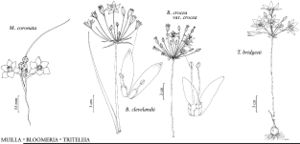Bloomeria
Proc. Calif. Acad. Sci. 2: 11. 1863.
| Taxon | Illustrator ⠉ | |
|---|---|---|
 | Muilla coronata Bloomeria crocea var. crocea Bloomeria clevelandii Triteleia bridgesii | Yevonn Wilson-Ramsey Yevonn Wilson-Ramsey Yevonn Wilson-Ramsey Yevonn Wilson-Ramsey |
Herbs, perennial, scapose, from fibrous-coated corms. Leaves 1–8, basal; blade linearlanceolate, keeled, margins entire. Scape slender, cylindrical, rigid. Inflorescences umbellate, open, 10–35-flowered, bracteate; bracts 2–4, scarious, membranous, not enclosing flower buds. Flowers: tepals 6, persistent, widely spreading, distinct or barely connate at base, golden yellow, striped brownish or green, nearly equal, oblong-linear, subrotate at anthesis; stamens 6, epitepalous, slightly shorter than and inserted at base of tepals; filaments filiform distally, dilated basally, ca. 6 mm, dilated bases sometimes connate into nectariferous cup, cup sometimes having basal filament appendages arising from apex; anthers subbasifixed, versatile; pistil 3-carpellate; ovary superior, sessile, 3-locular, ovules anatropous, several per locule; style persistent, splitting with capsule, filiform or clavate, 5 mm; stigma 3-lobed; pedicel long, erect, raylike, base and apex articulate. Fruits sessile, capsular, 3-angled, subglobose, 5–6 mm, dehiscence loculicidal. Seeds black, angular, subovoid, wrinkled, coat with crust. x = 9 (except for B. clevelandii x = 14).
Distribution
c and s Calif, Mexico (n Baja California)
Discussion
Species 3 (3 in the flora).
J. W. Ingram (1953) considered Bloomeria to be closely related to Brodiaea, Muilla, and Allium. R. F. Hoover (1941, 1955), on the other hand, considered it to be closely related to Triteleia, on the basis of corm morphology, keeled leaves, umbel structure, versatile anthers distant from the style, filament appendages, a stigma with three small lobes, similar seeds, and the same base chromosome number. However, Bloomeria differs generally from Triteleia in that it has distinct tepals and a sessile ovary, although the tepals of some B. crocea are slightly connate at the base, and T. ixioides has a very short perianth tube. Hoover kept the two genera separate on the basis of the stipitate ovary and geographic distribution. Triteleia rarely occurs south of the Tehachapi and the Santa Lucia Mountains in California, where Bloomeria occurs.
Among the most important diagnostic characters within Bloomeria are features of the androecium, particularly the orientation of the stamens relative to the style, and the appendages at the dilated bases of the filaments. These characters are easily seen in the field with a hand lens. When collecting flowering specimens, one should make a point of preparing a few dissected flowers in a manner that displays these critical characters.
Selected References
None.
Lower Taxa
Key
| 1 | Filaments leaning away from style, leaving dilated bases separated and therefore not forming nectariferous cup; style shorter than or equal to ovary; leaves 2–8, 1–3 mm wide. | Bloomeria clevelandii |
| 1 | Filaments parallel to style, dilated bases connate into nectariferous cup; style longer than ovary; leaves 1–2, 3–15 mm wide. | > 2 |
| 2 | Scape 15–70 cm; tepals abruptly spreading at base; leaves usually 1. | Bloomeria crocea |
| 2 | Scape 5–10 cm; tepals ascending at base, then gradually spreading; leaves usually 1–2. | Bloomeria humilis |
"broad" is not a number."thicker" is not a number.